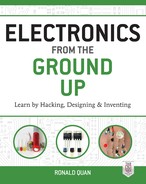Acknowledgments
I would like to thank very much Roger Stewart of McGraw-Hill, who encouraged me to write a second book. Without his support, this book would not have been written. Also, thanks to Amy Stonebraker, who coordinated my manuscript and figures.
In transforming my manuscript and figures into a wonderful book, I owe much gratitude to project manager, Patricia Wallenburg, and her team including the copy editor, James Madru, and proofreader, Claire Splan.
Writing a book generally requires a “sounding board” for feedback, and Andrew Mellows not only proofread the entire manuscript but also gave me very helpful comments on the technical matter. Thank you very much, Andrew, for your suggestions and comments.
Some material in this book pertaining to building and entry-level electronics came from working with Professor Robert W. Dutton at Stanford University. I give my greatest thanks to Bob Dutton for inviting me into the Electrical Engineering Department as a mentor in his classes and for his ongoing encouragement while I was writing this book. I was very privileged to work with him, lead teaching assistant Kevin Dade, and the very bright students in the Research Experience for Undergrads, Mechatronics, and Radio-Frequency labs that included students Kiran Rana Magar, Tyler Conklin, Luis Aguilar, Kevin Hsu, Jamie Nakamura, Rea Rostosky, Chet Gengy, Laza Upatising, Si Tan, Charles Guan, Jack Tsai, and all the others who participated. I thank you all very much.
Also, I owe immense gratitude to Professor Thomas H. Lee at Stanford University, who was responsible for my meeting with Bob Dutton in the first place and who throughout the years has encouraged me in my electronics research. And, of course, thank you to Stanford University.
Quite a few people inspired me this time around. I would like to first give great thanks to Jeri Ellsworth, whose videos and private communications provided me with some of the material I decided to include in this book, such as the Wein oscillator. Jeri not only inspired and encouraged me on this book but also on my first book, Build Your Own Transistor Radios, when I worked on SDRs (software-defined radios).
Another person who inspired me is Professor Robert G. Meyer at the University of California Berkeley. There are parts of this book that include looking into the large-signal behavior of transistors. His class notes, books, and lectures played an important role for me in writing the later chapters. So thank you Bob Meyer!
This book also goes into audio circuits, and I would like to thank John Curl for his insights in this area, including low-noise and low-distortion amplifier design. Larry Topping built and evaluated many of the audio circuits featured in Chapter 8, and I owe him much gratitude for that. I am also thankful to Robert K. LeBeck, Jr., who provided some much-needed information pertaining to audio circuits. Thank you to Chris Gammel for posting on his site suggestions for this book that resulted in a request for audio circuits. Also, I give my thanks to Dave Jones who provided me helpful information on the latest digital storage oscilloscopes.
With much appreciation, I also need to mention my two mentors from the industry, John O. Ryan and Barrett E. Guisinger. Both gave me a world-class education in analog and video circuits design. I learned about feedback-clamp circuits from John and resistor-capacitor image-enhancement circuits from Barrett.
During this whole process I have been indebted to the following friends for encouraging and supporting me: Alexis DiFirenzi Swale, Germano Belli, Edison Fong, George Almeida, and Jo Acierto Spehar.
I really got into my second career as an author/writer because of Paul Rako. He connected me with Roger Stewart, which started all this. Thanks to you, Paul. Also, I would like to state my appreciation to Galileo Academy of Science and Technology and its teachers, Eugene Wing and Doug Page, for their support. William K. Schwarze, who was my best teacher at Galileo, also deserves thanks for his ability to convey advanced mathematical concepts in a very clear manner.
My friend, James D. Lee, is an inspiration to me, and he also reviewed a part of my book.
Finally, I acknowledge a big debt of gratitude to members of my family, William, George, Thomas, and Frances, for their support.
And, of course, I dedicate this second book to my parents, Nee and Lai.
